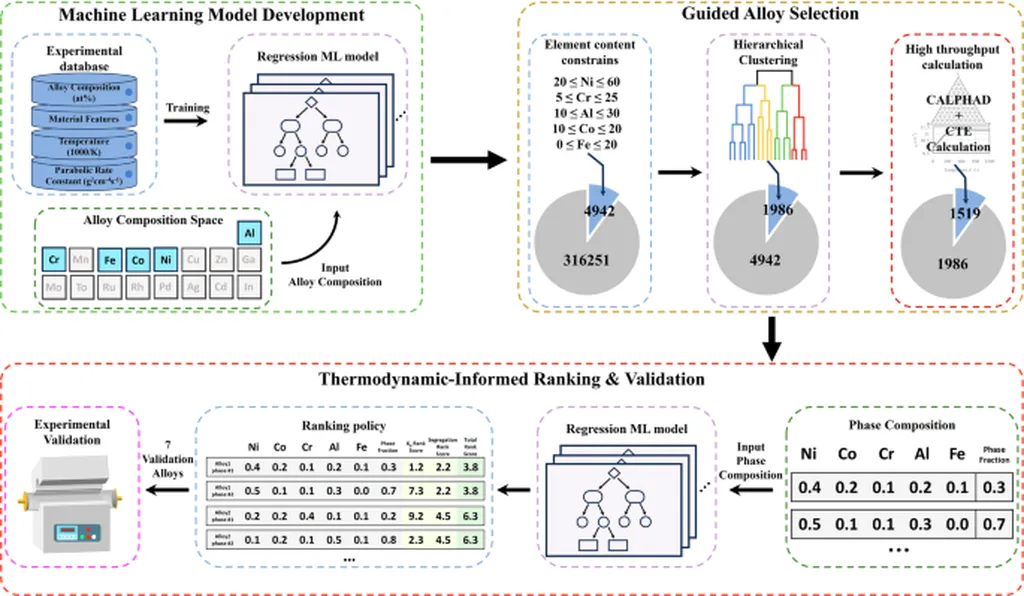In the ever-evolving landscape of materials science, a groundbreaking review published in the journal *Computational Materials Today* (which translates to *Computational Materials Today* in English) is set to revolutionize the way we develop high-entropy alloys (HEAs), particularly in the energy sector. Led by Abhishek Kumar from the Department of Physics at Banaras Hindu University in India, this research delves into the transformative potential of machine learning (ML) in the design and fabrication of HEAs, offering a glimpse into a future where data-driven approaches unlock unprecedented material properties.
High-entropy alloys, known for their multicomponent nature and unique mechanical properties, have long been a subject of fascination for researchers. These alloys, which consist of multiple principal elements in near-equiatomic ratios, exhibit exceptional strength, stability in corrosive environments, and high-temperature resistance. However, traditional methods of developing these materials have been time-consuming and often reliant on trial-and-error approaches.
Enter machine learning. Kumar and his team have meticulously reviewed recent advancements in applying ML techniques to HEA development. “Through multiple data analysis methods like supervised machine learning, unsupervised clustering, deep machine learning, and reinforcement machine learning, we can predict important material properties with greater accuracy and efficiency,” Kumar explains. This shift from conventional practices to data-driven frameworks is not just a technological upgrade; it’s a paradigm shift that could accelerate the discovery and optimization of HEAs for various applications, including the energy sector.
The implications for the energy industry are profound. HEAs with enhanced mechanical strength and stability can lead to more efficient and durable components in power generation, renewable energy systems, and energy storage solutions. For instance, the development of HEAs with superior hydrogen storage capacity could significantly impact the advancement of hydrogen fuel cells, a clean energy technology with immense potential.
Moreover, the integration of ML with computational approaches such as calculation of phase diagrams (CALPHAD), first-principle methods, and molecular dynamics has fortified the models of HEAs, making them more reliable and predictive. This synergy between ML and computational techniques is paving the way for a new era of materials science, where the boundaries of what is possible are continually expanded.
However, the journey is not without its challenges. Kumar and his team highlight critical issues such as data limitations, model explainability, and the computational complexity of applying ML to HEA development. Addressing these challenges will require collaborative efforts, data sharing, and the development of better algorithms. “The future of ML-driven materials discovery lies in our ability to overcome these hurdles and create a robust, data-driven framework for optimizing HEA properties,” Kumar notes.
The review also underscores the importance of physics-informed constraints in enhancing the accuracy and reliability of ML models. By incorporating fundamental physical principles into the learning process, researchers can ensure that the predictions and optimizations are grounded in scientific reality.
As we look to the future, the role of machine learning in the development of high-entropy alloys cannot be overstated. The case studies presented in the review demonstrate the tangible benefits of ML in discovering new HEAs, supporting the usefulness of this approach in materials science. With continued advancements in data sharing, algorithm development, and physics-informed constraints, the potential for ML to drive future breakthroughs in HEAs is vast.
In conclusion, the research led by Abhishek Kumar offers a compelling vision of a future where machine learning and high-entropy alloys converge to create materials with unprecedented properties. For the energy sector, this means more efficient, durable, and innovative solutions that can meet the demands of a rapidly evolving world. As we stand on the brink of this new era, one thing is clear: the future of materials science is data-driven, and the possibilities are limitless.

